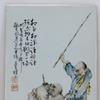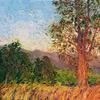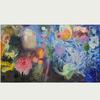Impact, Movement, and Simplification: Paintings by Charles Green Shaw, 1966-70
- NEW YORK, New York
- /
- February 14, 2012
Spanierman Gallery is pleased to announce the opening on February 23, 2012 of Impact, Movement, and Simplification: Paintings by Charles Green Shaw, 1966-70, an exhibition featuring the extraordinary group of paintings Shaw (1892-1974) created from 1966 through 1970 in which he returned to his hard-edge style of the 1930s, while drawing from the Minimalist art of the 1960s. Shaw described these works as “not rectangular, but angular . . . . in which I feel . . .I have the qualities I am after: impact, movement, and simplification, plus texture.” In the paintings, he limited his palette to combinations of two or three colors, and his compositions to a few broadly treated forms, while filling in some of the shapes with a roughened surface texture—unusual in Minimalist paintings—to provide contrast and emphasis. Elegant in their restraint, the paintings explore the nature of perceptual experience, providing insight for the viewer into the ways in which we often see what we want and expect to see. The show is accompanied by a brochure with an essay by Lisa N. Peters, Ph.D.
An artist who hailed from a background of wealth and privilege, Charles Shaw was a writer and journalist before he became an artist. His friends included Cole Porter (his classmate at Yale University), George Gershwin, Irving Berlin, the drama critic George Jean Nathan, the editor Henry Mencken, and F. Scott Fitzgerald. He turned to art as a career during a three-year stay in Europe, when he visited the studios of Picasso, Braque, and other avant-garde artists of the time in the company of Albert Gallatin. On his return to New York, Shaw began to produce works in which he extended a modernist vocabulary to an American idiom. Creating semi-cubist images based on the profiles of Manhattan buildings, he developed what he termed “the plastic polygon.”
During the 1930s, Charles Shaw was part of the small group of American artists who remained committed to abstraction in a time when a strong nativist current compelled artists to focus on realistic and celebratory images of American life. In 1936, he was among the founding members of the American Abstract Artists, along with such artists as Byron Browne, Burgoyne Diller, Harry Holtzman, Ibram Lassaw, and Albert Swinden. Shaw broadened his art in the years ahead, experimenting with aspects of Constructivism, the biomorphic art of Hans Arp, the witty playfulness of Paul Klee, and the Neo-Plasticism of Piet Mondrian. In the 1940s, he embraced the emergence of the New York School, and in the next decade, he incorporated the gestural techniques of Abstract Expressionism into his art. He expressed his enthusiasm for the new art to his friend Charles H. Carpenter Jr., stating that he felt proud that “American art had finally ‘made it.’” Of the artists of the era, he had a particular admiration for the work of Ellsworth Kelly and Frank Stella, which resonated with his own.
It was in the mid-1960s that he found his own voice within the multi-faceted art world of the period, a time when Color Field, Pop, Conceptual, and Process Art as well as Minimalism were prominent. The result was the reductive and bold group of images included in this exhibition, in which Charles Shaw followed a Minimalist ideology that the eye can see more than what is there. Using the circle and the polygon as a basis, Shaw used a reductive language of suggestion in which the viewer is made aware of the ways in which the juxtaposition of forms creates a sense of motion and impact, eliciting our perceptual faculties to conjoin and complete spatial and temporal relationships.
Charles Shaw’s work is included in numerous museum collections throughout the country, including Ackland Art Museum, University of North Carolina, Chapel Hill; Addison Gallery of American Art, Andover, Massachusetts; Art Institute of Chicago; Baltimore Museum of Art, Maryland; Brooklyn Museum, New York; Carnegie Museum of Art, Pittsburgh; Corcoran Gallery of Art, Washington, D.C.; Dayton Art Institute, Ohio; Denver Art Museum; Edwin A. Ulrich Museum of Art, Wichita State University, Kansas; High Museum of Art, Atlanta; Joslyn Art Museum, Omaha, Nebraska; McNay Art Museum, San Antonio, Texas; Metropolitan Museum of Art, New York; Museum of Fine Arts, Boston; Museum of Modern Art, New York; Newark Museum, New Jersey; Pennsylvania Academy of the Fine Arts, Philadelphia; Phillips Collection, Washington, D.C.; Phoenix Art Museum, Arizona; San Francisco Museum of Modern Art; Sheldon Museum of Art, Lincoln, Nebraska; Smithsonian American Art Museum, Washington, D.C.; Solomon R. Guggenheim Museum, New York; Whitney Museum of American Art, New York; and Yale University Art Gallery, New Haven, Connecticut.
Contact:
Bethany DobsonSpanierman Gallery, LLC
212-832-0208
bethanydobson@spanierman.com
53 East 58th Street
New York, New York
info@spanierman.com
212-832-0208
http://www.spaniermanmodern.com/12-Charles-Green-Shaw/12-Charles-G-Shaw.htm
About Spanierman Gallery, LLC
American art from the 19th century to the present. Serving the fine arts community for over half a century.

100x100_n.jpg)
100x100_c.jpg)










100x100_c.jpg)


